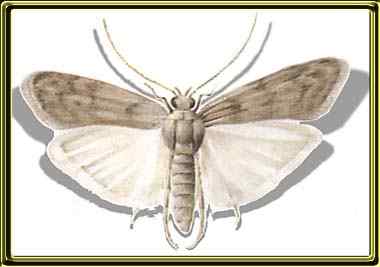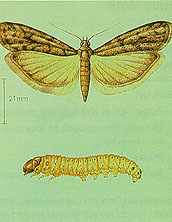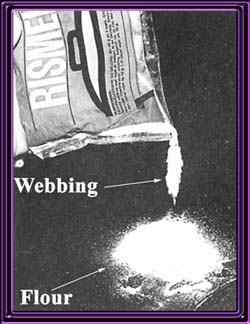
Ephestia
kuehniella
(Mill or Flour Moth)
(can also be Mediterranean Flour Moth)
This moth originally came from India. It was first found in Europe in about 1877 in some American wheat. Nowadays there are few concerns dealing with flour and cereals which do not suffer from time to time from the depredations of this moth. It may also become a concern in households, though these days this is less likely. Another picture below shows the larvae which does all the damage.
Courtesy of Oklahoma State University
A major pest of flour mills, its main habitats are flour and grout mills, corn milling plants, bakeries and any other place used for processing grains or preparing flour products. E. kuehniella occurs in most of the temperate and sub-tropical parts of the world, where average temperatures are around 20°C - 25°C. Complete development requires about 74 days at 25°C and 75% relative humidity. Larvae entwine all the material on which they feed resulting in solid lumps of food particles, faeces and larval exuviae. Adults are similar to E. cautella but the body is relatively longer.
This insect is found world-wide. Depending on temperature and humidity, a single female may lay up to 562 eggs. Optimum temperature is 26º C. At 27º C temperature, timing for development of a generation varies from 43 to 72 days, and from 140 to 243 days at 10º C. It can only develop up to 35º C.
Life cycle takes three to four months, under adequate conditions of temperature and air humidity (70%).
It is generally similar to E. elutella (which we haven't covered yet), but larvae become pupae within the food. Eggs are laid near the products where they feed. Larvae move quickly, feeding and producing silk, creating webs. The product also acquires an unpleasant smell and a grey/brown colour due to the faeces. They grow completely and form pupae within the same products they infest. Silk may form compact masses (webbing) that may obstruct tubes and shoots in wheat mills, in fact it has been known to bring machinary to a standstill, and serve as an undercover for other insects that damage grains and stored products.
Adults are short lived (approximately 14 days), do not feed and usually fly near the roofings. They fly more actively at the early morning and late afternoon.Mill moth larvae prefer wheat flour, but will also feed on all sorts of grains, cereals, seeds, macaroni, dried fruits, cocoa, nuts and almonds.
Treatment:
The treatment is as for all stored product pests, scrupulous housekeeping, regular pest control inspections which give detailed feed-back, so that any problems can be spotted early and dealt with. If the problem gets bad, then the only way is to fumigate allied with a spraying program of alighting surfaces, cracks and crevices, (where the larvae and pupa may be residing). There are developments at various establishments, which are using the biological approach, use of other insects including mites fungi which are showing prospects, but these are in the future and we are still using gases.
Back to main Stored Product Insect page

